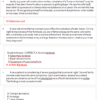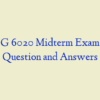Description
NSG 6020 Week 2 Quiz. Functional Assessments and Cultural and Diversity Awareness in Health Assessment
- The dorsal surface of the hand is most often used for the assessment of:
- Informing a patient that he or she has a terminal illness is most likely to be discouraged in which cultural group?
- According to the guidelines for Standard Precautions:
- Knowledge of the culture or cultures represented by the patient should be used to:
- A 22-year-old female nurse is interviewing an 86-year-old male patient. The patient avoids eye contact and answers questions only by saying, Yeah, No, or I guess so. Which of the following is appropriate for the interviewer to say or ask?
- Observing the rise and fall of the abdomen usually facilitates the calculation of respiratory rate in the:
- What additional factors besides race and nationality compose an ethnos or ethnic group?
- For a woman with a small vaginal opening, the examiner should use a _____ speculum.
- Axillary measurement of temperature correlates best with core temperatures of:
- During auscultation, you can limit your perceptual field best by:
- Tuning forks with a frequency of 500 to 1000 Hz are most commonly used to measure:
- A naturalistic or holistic approach to health care often assumes:
- A non-ambulatory 80-year-old male patient tells the female nurse that he feels like he is having drainage from his rectum. Which initial nursing action is appropriate?
- Your new patient is a 40-year-old Middle Eastern man with a complaint of new abdominal pain. You are concerned about violating a cultural prohibition when you prepare to do his rectal examination. The best tactic would be to:
- Which of the following statements is true regarding tympanic membrane temperature?
- A fixed image of any group that rejects its potential for originality or individuality is known as a(n): Stereotype
- The stethoscope s diaphragm is most useful in the assessment of _____ sounds.
- Being sensitive to cultural differences that may exist between you and the patient is most useful in the avoidance of:
- As you explain your patient s condition to her husband, you notice that he is leaning toward you and pointedly blinking his eyes. Knowing that he is from England, your most appropriate response to this behavior is to:
- The use of secondary, tangential lighting is most helpful in the detection of:







